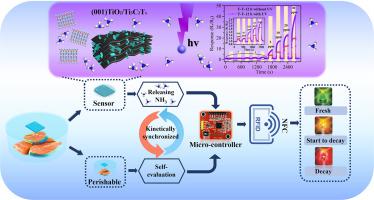Journal of Hazardous Materials ( IF 13.6 ) Pub Date : 2021-09-09 , DOI: 10.1016/j.jhazmat.2021.127160 Dongzhi Zhang 1 , Sujing Yu 1 , Xingwei Wang 1 , Jiankun Huang 2 , Wenjing Pan 1 , Jianhua Zhang 1 , Benjamin Edem Meteku 2 , Jingbin Zeng 2

|
Ammonia has been used as an important marker to indicate the extent of food spoilage. However, current gas sensors for ammonia suffer from either insufficient sensitivity and selectivity or unsatisfactory levels of automation, impeding their practical application for on-site and real-time monitoring of food quality. To overcome these limitations, we propose here the design of a sensing material by in-situ growing (001)TiO2 onto a two-dimensional transition-metal carbide (Ti3C2Tx, MXene). In this design, TiO2 with a highly active (001) crystal plane provides efficient photogeneration under UV irradiation, while Ti3C2Tx can store holes through Schottky junction formed at the interface with TiO2, which greatly promotes the separation of electron-hole pairs, thereby enhancing ammonia sensing performance. By further introducing UV light for electron excitation, the (001)TiO2/Ti3C2Tx based sensor shows 34 times higher sensitivity for ammonia (30 ppm) than that of Ti3C2Tx. The density functional theory further revealed that the (001) plane of TiO2 and Ti3C2Tx composite configuration exhibited the highest adsorption affinity towards ammonia. Finally, an integrated circuit alarm system including near-field communication and a micro-controller system was designed to detect the decay process of fresh pork, fish, and shrimp. We believe such a sensing technology holds great promise in food quality monitoring.
中文翻译:

基于(001)TiO2/MXene异质结构的紫外光照增强超灵敏氨气传感器用于食品腐败检测
氨已被用作指示食物腐败程度的重要标志。然而,目前的氨气传感器要么灵敏度和选择性不足,要么自动化水平不理想,阻碍了其在现场和实时食品质量监测中的实际应用。为了克服这些限制,我们在此提出通过将 (001)TiO 2原位生长到二维过渡金属碳化物 (Ti 3 C 2 T x , MXene) 上来设计传感材料。在该设计中,具有高活性 (001) 晶面的 TiO 2在紫外线照射下提供了高效的光生作用,而 Ti 3 C 2 T x可以通过与TiO 2界面形成的肖特基结储存空穴,极大地促进了电子-空穴对的分离,从而提高了氨传感性能。通过进一步引入用于电子激发的紫外光,基于 (001)TiO 2 /Ti 3 C 2 T x的传感器对氨 (30 ppm) 的灵敏度比 Ti 3 C 2 T x高 34 倍。密度泛函理论进一步揭示了TiO 2和Ti 3 C 2 T x的(001)面复合结构对氨表现出最高的吸附亲和力。最后,设计了一种包括近场通信和微控制器系统的集成电路报警系统,用于检测新鲜猪肉、鱼和虾的腐烂过程。我们相信这种传感技术在食品质量监测方面具有很大的前景。



























 京公网安备 11010802027423号
京公网安备 11010802027423号